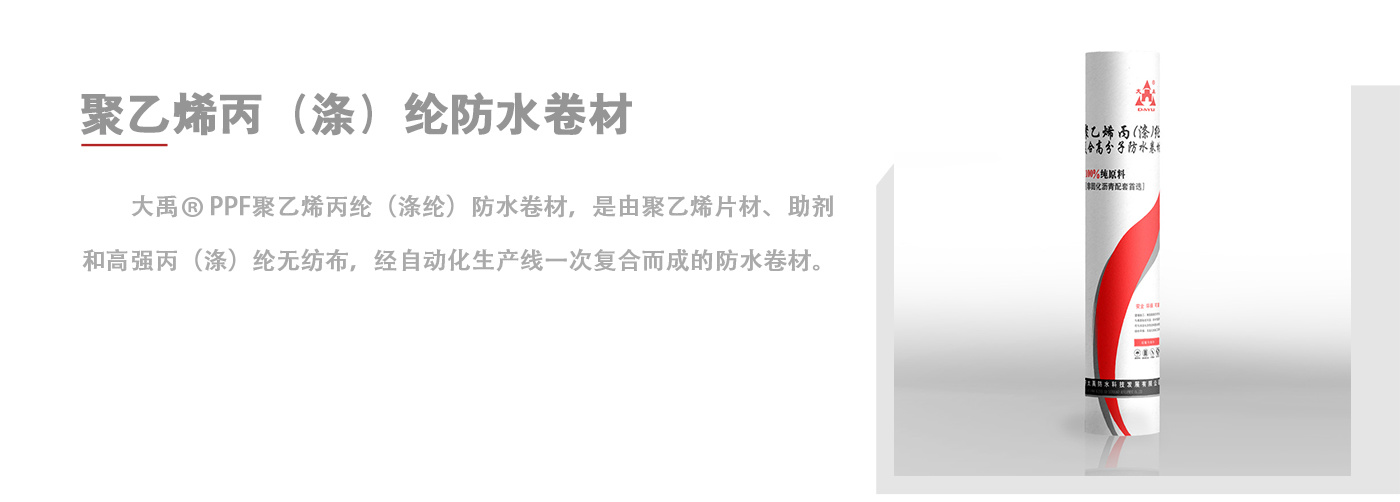
Product overview
Dayu®PPF polyethylene polypropylene (polyester) waterproofing membrane is a waterproofing membrane made of polyethylene sheet, additives and high-strength polypropylene (polyester) non-woven fabric, which is compounded by an automatic production line.
l Polyethylene Sheet: Pure virgin polyethylene particles.
l Auxiliaries: anti-aging agent, stabilizer, sticking agent, etc.
Product Features
l High tensile strength, strong impermeability and low expansion coefficient.
l Pure raw polyethylene raw material manufacturing, high temperature does not wrinkle, low temperature is not brittle,-40 ℃ ~ 60 ℃ environment is stable and not deformed.
l The use of cement cementitious material paste, the base surface requirements are low, the scope of adaptation is wide, the construction is simple and easy.
l No open flame, no solvent, green environmental protection.
Specification classification
|
Kind |
FS2 (polypropylene) |
|
Thickness |
0.7mm/0.8mm/0.9mm/1.2mm |
|
Width |
1000mm/1200mm |
|
Length |
50m/100m |
Scope of application
l It is suitable for industrial, civil, municipal and other construction projects, including administrative, residential, commercial, scientific research, medical, school, grain depot, pipe gallery and other buildings.
l Applicable to the construction of underground engineering, roofing engineering, kitchen and bathroom engineering.
l Suitable for planting green roof, pipe gallery roof and landscape water system.
Construction process
l Basic requirements: solid, no sediment, laitance, no empty drum, loose, sand and other phenomena.
lInterface treatment: wetting the base layer to a wet state without open water.
l Preparation of mucilage: according to the temperature and humidity, add clean water into the batching barrel according to the water cement ratio of 0.35~0.40, then add appropriate amount of 42.5Mpa ordinary Portland cement, and fully mix into uniform, fine and non-lumpy cement slurry. The construction of the facade should be mixed with 0.5 ~ 1% by weight of the slurry.
l Trial laying of coiled material: lay the coiled material flat on the base surface, align the elastic line or the overlapping edge of adjacent coiled material, adjust the overlapping width, and rewind after standing for a period of time to release the stress.
l Scraping glue: the glue is scraped on the base (plane) or scraped on the coil bonding surface (elevation), with a thickness of 2~3mm.
l Spreading coil: push and roll forward to lay the coil, drive the slurry and exhaust, so that the coil is closely bonded with the mucilage and the base.
performance index
Products in accordance with the national standard "polymer waterproof material part 1: sheet" GB18173.1-2012 production and manufacturing.
Performance indicators meet standard requirements
List of physical performance indicators of coil parts:
|
Project |
Indicator (FS2) |
|
Tensile strength (normal temperature) |
≥60 n/mm |
|
Elongation at break (normal temperature) |
≥ 400% |
|
Tear strength |
≥50 N |
|
impervious to water |
0.3MPa,30min, no leakage |
|
low temperature bending |
-20 ℃, no crack |
|
Composite strength (FS2 type skin and core) |
≥ 0.8 MPa |
|
For FS2 composite sheets with a total thickness of less than 1.0mm, the tensile strength (longitudinal/transverse) index shall not be less than 50N/cm at normal temperature (23 ℃), and the elongation at break (longitudinal/transverse) index shall not be less than 100 at normal temperature (23 ℃). |
|
Previous Page
Previous Page
Next Page


